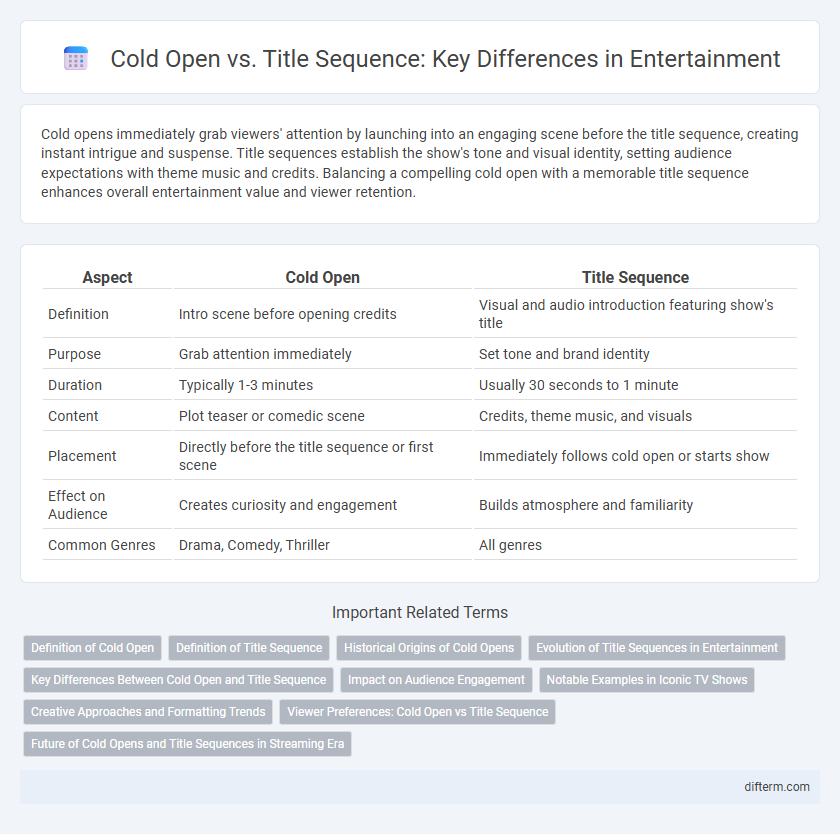Cold opens immediately grab viewers' attention by launching into an engaging scene before the title sequence, creating instant intrigue and suspense. Title sequences establish the show's tone and visual identity, setting audience expectations with theme music and credits. Balancing a compelling cold open with a memorable title sequence enhances overall entertainment value and viewer retention.
Table of Comparison
| Aspect | Cold Open | Title Sequence |
|---|---|---|
| Definition | Intro scene before opening credits | Visual and audio introduction featuring show's title |
| Purpose | Grab attention immediately | Set tone and brand identity |
| Duration | Typically 1-3 minutes | Usually 30 seconds to 1 minute |
| Content | Plot teaser or comedic scene | Credits, theme music, and visuals |
| Placement | Directly before the title sequence or first scene | Immediately follows cold open or starts show |
| Effect on Audience | Creates curiosity and engagement | Builds atmosphere and familiarity |
| Common Genres | Drama, Comedy, Thriller | All genres |
Definition of Cold Open
A cold open is a narrative technique in television and film where the story begins immediately without any opening credits or title sequence, designed to grab audience attention instantly. This segment usually presents a compelling or suspenseful scene that sets up the episode's plot, often leaving viewers eager to see how the story develops. Unlike the title sequence, which provides visual and thematic introduction along with credits, the cold open bypasses formalities to immerse viewers directly into the action.
Definition of Title Sequence
The title sequence is a carefully crafted segment at the beginning of a show or film that presents the title and key credits, often accompanied by thematic music and visuals that set the tone for the story. Unlike a cold open, which starts with action or dialogue before the titles appear, the title sequence serves to introduce the brand identity and establish the mood for the audience. This sequence often includes animated graphics or stylized typography, creating a memorable and immersive experience that reinforces the entertainment's stylistic elements.
Historical Origins of Cold Opens
Cold opens trace back to early radio shows in the 1930s, designed to immediately capture audience attention before theme music or titles. This technique evolved in television during the 1950s, popularized by sitcoms like "The Twilight Zone" which employed dramatic scenes right before the title sequence. Unlike traditional title sequences that formally introduce the show, cold opens create suspense and engagement, setting the tone and context without preliminary delay.
Evolution of Title Sequences in Entertainment
Title sequences have evolved from simple text overlays to dynamic, immersive visual experiences that set the tone and atmosphere of a film or television show. Cold opens grab immediate attention by plunging viewers into action or drama before the official title sequence, which now often incorporates advanced CGI, thematic music, and symbolic imagery to enhance storytelling. This progression reflects a shift toward integrating branding and narrative, making title sequences a critical element in audience engagement and entertainment marketing.
Key Differences Between Cold Open and Title Sequence
Cold open immediately engages viewers by presenting a scene or dramatic moment before the title sequence, setting the tone or building suspense without initial credits. Title sequences formally introduce the show or movie with visual and auditory branding, often including main cast and crew information. The primary difference lies in timing and purpose: cold opens grab attention upfront, while title sequences establish official identity and context.
Impact on Audience Engagement
Cold opens grab audience attention immediately by dropping viewers into an intense or intriguing moment, increasing emotional investment before the title sequence begins. Title sequences establish tone, theme, and mood, helping viewers mentally prepare and set expectations for the episode or film. Combining a strong cold open with a memorable title sequence maximizes sustained audience engagement by balancing surprise with narrative context.
Notable Examples in Iconic TV Shows
Cold opens, often seen in shows like "Breaking Bad," grab viewers' attention with immediate action or suspense before the title sequence, enhancing engagement. Iconic series such as "Friends" and "The Simpsons" utilize memorable title sequences that establish tone and character introductions, becoming culturally significant over time. Notable examples highlight how cold opens build intrigue, while title sequences provide branding and narrative context in entertainment.
Creative Approaches and Formatting Trends
Cold opens leverage immediate engagement by launching viewers directly into action or intrigue before any titles appear, fostering suspense through an unorthodox narrative jumpstart. Title sequences traditionally establish tone and setting with stylized visuals and music, yet recent trends favor minimalist or integrated openings that blend seamlessly with story onset. Creative approaches increasingly merge cold opens with dynamic typography and animation, reflecting evolving audience preferences for immersive and concise storytelling formats.
Viewer Preferences: Cold Open vs Title Sequence
Viewer preferences often lean toward cold opens for their ability to immediately engage audiences by presenting a gripping or humorous scene before the formal title sequence. Cold opens increase retention rates by creating immediate curiosity and suspense, essential in streaming platforms where attention spans are short. However, traditional title sequences remain valued for establishing tone, brand identity, and thematic elements, appealing to viewers who enjoy narrative context and visual artistry.
Future of Cold Opens and Title Sequences in Streaming Era
Cold opens captivate viewers immediately, providing quick hooks that drive binge-watching behavior essential for streaming platforms' algorithms. Title sequences are evolving into dynamic, personalized experiences that enhance brand identity and viewer retention by integrating interactive elements and adaptive storytelling. The future of cold opens and title sequences lies in leveraging data analytics and AI to create immersive, tailored introductions that optimize user engagement across diverse streaming services.
Cold open vs Title sequence Infographic

 difterm.com
difterm.com